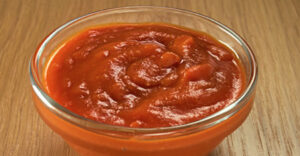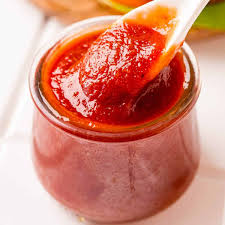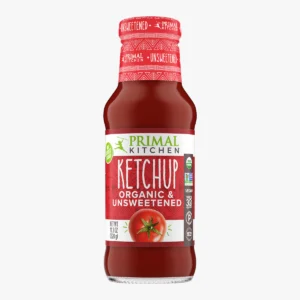Tomato Ketchup: The American invention that became worldwide condiment

I can’t remember ever not liking ketchup. The strange thing is, neither can I remember being overly crazy about the stuff. Okay, admittedly I’ve always felt my basket of French fries was totally lacking unless there was ketchup in which to dip them. And, I always enjoyed ketchup on my momma’s roast beef, and as a topping for meatloaf.
But I could never understand putting ketchup on a burger (at least not before McDonalds came to town) instead of a thick slice of fresh tomato. Neither, in my opinion, does it have a place on scrambled eggs or omelets. And, to dress your hot dog with ketchup is an absolute abomination. Now I know there’s a lot of you folks that totally disagree with me on this, and that’s okay. As I always say: To each his own.
Ketchup can be found in about 97% of America’s 125 million households. And friends, that’s one hell of a lot of ketchup. In fact, the average American eats about 71 pounds of the tomatoey stuff every year. But, when it comes to the history of this sauce, tomato-based ketchup is a relatively recent event.
Most historians believe the precursor to ketchup dates as far back as 300 B.C. China, where it began as a fermented fish sauce called “kê-tsiap.” From there, the sauce made its way along the trade  routes to Malaysia, Singapore, and Indonesia, where the indigenous people introduced it to 18th century British colonists.
routes to Malaysia, Singapore, and Indonesia, where the indigenous people introduced it to 18th century British colonists.
Kê-tsiap, or “kecap” as it was known in Indonesia, eventually made its way back to England where the recipe was immediately corrupted. Early English cookbooks featured ketchup recipes calling for all sorts of ingredients, including oysters, mussels, mushrooms, walnuts, lemons, celery, plums, and peaches. The 1727 cookbook, The Compleat Housewife by English author Eliza Smith, featured the following, first ever published “katchup” recipe, a rather thin anchovy-based creation.
“Take a wide mouth’d Bottle, put there a Pint of the best White-wine Vinegar, then put in ten or twelve Cloves of Eschalot, peeled and just bruised; then take a quarter of a Pint of the best Langoon White-wine; boil it a little, and put to it twelve or fourteen Anchovies washed and shred, and dissolve them in the Wine, and when cold put them in the Bottle; then take a quarter of a Pint more of White-wine, and put in it Mace, Ginger sliced, a few Cloves, a Spoonful of whole Pepper, just bruised; let them boil all a little; when near cooked, slice in almost a whole Nutmeg, and some Lemon peel, and likewise put in two or thee Spoonfuls of Horseradish; then stop it close, and for a Week shake it once or twice a Day, then use it; ’tis good to put into Fish Sauce, or savory Dish or Meat; you may add to it the clear Liquor that comes from Mushrooms.”
Forty-seven years later, another extremely popular English cookbook, The Art of Cookery, Made Plain and Easy, by Hannah Glasse, included on pages 216 and 217 two different “catsup” recipes, neither of which contained any seafood. While the first was basically mushroom broth to which spices and red wine were added, the second recipe was a bit more complex:
“Take the largest faps of mushrooms gathered dry, and bruise them ; put some at the bottom of an earthen pan , strew some salt over, then mushrooms, then salt, till you have done. . . .Let them stand six days, stir them up every day ; boil the liquor, drain I through a little flannel bag ; to a quart of that liquor put a quart of stale beer a large stick of horse-radish, but with little slips, five or six bay leaves, an onion stuck with twenty or thirty cloves, a quarter of an ounce of mace, a quarter of an ounce of nutmegs, eat, a quarter of an ounce of black and white pepper, a quarter of an ounce of all-spice, and four or five races of ginger. Cover it close, and let it simmer very softly till about one third is wasted ; then strain it through a flannel bag ; when it is cold bottle it in pint bottles, cork it close, and it will keep a great while.”
Not only did it seem during that time to be some lack of consensus on how best to make this new sauce, no one could agree on its spelling. Was it ketchup, catsup, or catchup? The Domestic Chemist, an 1831 England publication addressed the craziness of the issue as follows: “These three words indicate a sauce, of which the name can be pronounced by every body, but spelled by nobody.” It goes on to say, “True ketchup is the liquor produce by the liquidation of salted mushrooms.” Still, no mention of tomatoes.
Ketchup Comes to America
Just as mushroom-based ketchup had become the standard in the UK, so it was with the British colonists in America. A 1770 cookbook from Charleston, South Carolina written by Harriott Pinckney Horry included a Mushroom Catchup recipe that used two egg whites to  clarify the mixture. It also contained a recipe for Walnut Catchup.
clarify the mixture. It also contained a recipe for Walnut Catchup.
Late eighteenth century America brought about experimentation with new ketchup ingredients, including the “love apple” a term by which tomatoes were known at the time. At first, tomato ketchups, like mushroom catsups, were homemade and every household had their own recipe, consisting basically of ripe tomatoes, cooked, strained, and seasoned with various spices, much like ketchups of today.
 In 1812, Philadelphia scientist and horticulturist James Mease is credited with the first published tomato-based ketchup recipe. Mease’s recipe called for tomato pulp, spices and brandy, but no vinegar or sugar. Over the next several years recipes for tomato ketchup appeared in every popular American cookbook including The Virginia Housewife by Thomas Jefferson’s cousin, Mary Randolph. In it she wrote:
In 1812, Philadelphia scientist and horticulturist James Mease is credited with the first published tomato-based ketchup recipe. Mease’s recipe called for tomato pulp, spices and brandy, but no vinegar or sugar. Over the next several years recipes for tomato ketchup appeared in every popular American cookbook including The Virginia Housewife by Thomas Jefferson’s cousin, Mary Randolph. In it she wrote:
"Gather a peck of tomatos, pick out the stems, and wash them; put them on the fire without water, sprinkle on a few spoonsful of salt, let them boil steadily an hour, stirring them frequently; strain them through a colander, and then through a sieve; put the liquid on the fire with half a pint of chopped onions, half a quarter of an ounce of mace broke into small pieces; and if not sufficiently salt, add a little more--one table-spoonful of whole black pepper; boil all together until just enough to fill two bottles; cork it tight. Make it in August, in dry weather."
While America’s taste for this modern new tomato-based ketchup grew quickly, its popularity came with one big problem — no sugar or vinegar translated into short shelf life. It would be after the Civil War before these two components were added.
In 1837 Jonas Yerkes became the first person to produce and distribute bottled ketchup nationally, freeing housewives from the drudgery of making it in their own kitchen. Noting Yerkes success, other manufacturers were quick to follow suit. But, the lack of health and safety regulations within the food manufacturing industry as a whole, coupled with other issues made the process wrought with problems. In fact cookbook author Pierre Blot described commercial ketchups in 1866 as being, “filthy, decomposed and putrid.”
For one thing, the growing season was too short to provide fresh tomatoes year-round so manufacturers were forced to preserve pulp in storage barrels. Unfortunately this was done with the same  careless, unsanitary conditions found throughout the food industry, resulting in moldy, bacteria ridden tomato pulp. To circumvent these failings they resorted to adding harmful preservatives like boric and salicylic acids to their ketchup, as well as coal tar to retain the red color. And if that were not enough, many manufacturers cooked their ketchup in copper kettles, resulting in a chemical reaction that made their product poisonous. An 1896 study of commercial ketchups actually found 90% to contain “injurious ingredients” that could lead to death. And yet many unscrupulous ketchup producers used brown, green and blue bottles as a means of obscuring the shoddy quality of their product from unsuspecting customers.
careless, unsanitary conditions found throughout the food industry, resulting in moldy, bacteria ridden tomato pulp. To circumvent these failings they resorted to adding harmful preservatives like boric and salicylic acids to their ketchup, as well as coal tar to retain the red color. And if that were not enough, many manufacturers cooked their ketchup in copper kettles, resulting in a chemical reaction that made their product poisonous. An 1896 study of commercial ketchups actually found 90% to contain “injurious ingredients” that could lead to death. And yet many unscrupulous ketchup producers used brown, green and blue bottles as a means of obscuring the shoddy quality of their product from unsuspecting customers.
Enter Henry Heinz
At the age of 25, Henry J. Heinz partnered with his neighbor Clarence and brother E.J. Noble in 1860 to form the Heinz and Noble Company, producers and sellers of bottled horseradish sauce, using  his mother's recipe. While their company was quickly a success, it was unfortunately short-lived due to the panic of 1873, a major U.S. financial crisis that led to the failure of 18,000 businesses and a 14% rise in unemployment.
his mother's recipe. While their company was quickly a success, it was unfortunately short-lived due to the panic of 1873, a major U.S. financial crisis that led to the failure of 18,000 businesses and a 14% rise in unemployment.
In 1876, Henry formed a new company, the F & J Heinz Company, with his brother and their cousin, Fredrick. The new company manufactured and sold pickles, canned goods, and condiments. After a few successful years Henry bought out his partners, reorganized the company, and renamed it the H.J. Heinz Company, with its main focus being tomato ketchup.
Incorporating some of his innovations developed in his horseradish days, Heinz used clear glass bottles for his ketchup, so customers could see the product wasn’t spoiled. His bottles were octagonally shaped with a narrow neck (that he later patented) that prevented air from entering and discoloring the product.
Heinz was the first American manufacturer to create preservative free ketchup, by using vinegar, salt, and sugar in his formulation, even though it made his product 10 or 20-cents more expensive than his competitors. He was also a major advocate for safe-food manufacturing and a vocal supporter of the Food and Drug Administration. Heinz became known for having Immaculately clean factories, with workers in company supplied fresh, clean uniforms.
Over the years, Heinz has been responsible for a number of firsts: foil ketchup packets, plastic ketchup tubs with peel-off foil lids, the top-down-bottle, colored ketchup (no longer available), and the “Dip and Squeeze” packet. The H.J. Heinz company produces more than 650 million bottles of ketchup a year and enjoys 60 percent of the U.S. market (80 percent in the UK).
 Before leaving Heinz, let’s clear up the “57-Varieties” myth. As the story goes, in 1896 Heinz was on a train in New York when he saw a sign advertising “21 styles of shoes.” Thinking that was a clever marketing approach, he wanted to apply a similar scenario to his ketchup, so he came up with the 57-variety slogan. At that time, the H.J. Heinz company was already selling more than 60 different products. Henry said he chose the number 57 by combining his lucky number 5 with his wife’s 7. Today the company sells in excess of 5,500 different products.
Before leaving Heinz, let’s clear up the “57-Varieties” myth. As the story goes, in 1896 Heinz was on a train in New York when he saw a sign advertising “21 styles of shoes.” Thinking that was a clever marketing approach, he wanted to apply a similar scenario to his ketchup, so he came up with the 57-variety slogan. At that time, the H.J. Heinz company was already selling more than 60 different products. Henry said he chose the number 57 by combining his lucky number 5 with his wife’s 7. Today the company sells in excess of 5,500 different products.
World’s leading ketchup brands
Considering Heinz set the gold standard for tomato ketchup way back in 1876, there should be no doubt that it’s the world’s leading ketchup. In fact, six out of the ten top ketchup consuming countries noted the iconic 57-Varieties brand as their favorite.
In July of 2015 Kraft Foods Group and H.J. Heinz Holding Corporation merged, forming the world’s fifth-largest food and beverage company, and the third-largest in North America.
 Next is Primal Kitchen Ketchup, another Kraft Heinz Company brand. Primal Kitchen is a healthy, organic ketchup that is free from gluten, grains, soy, dairy, and refined sugar. This vegan ketchup is Whole 30 approved as well as Paleo and Keto certified.
Next is Primal Kitchen Ketchup, another Kraft Heinz Company brand. Primal Kitchen is a healthy, organic ketchup that is free from gluten, grains, soy, dairy, and refined sugar. This vegan ketchup is Whole 30 approved as well as Paleo and Keto certified.
In third place is Annie’s Organic Ketchup. Made from California-grown tomatoes and a secret blend of spices, Annie’s is certified USDA Organic and a gluten free, vegan, non-GMO ketchup, and part of the General Mills family.
 Fourth place goes to McCormick & Company’s French’s tomato ketchup. This flavorful ketchup a product of Canada, is made with fresh, ripe, 100% Canadian grown tomatoes, sugar, vinegar, onion powder and a variety of herbs and spices. French’s, best known for its mustard, began making ketchup in 2014 after reviving an old Heinz production facility in Leamington, Ontario.
Fourth place goes to McCormick & Company’s French’s tomato ketchup. This flavorful ketchup a product of Canada, is made with fresh, ripe, 100% Canadian grown tomatoes, sugar, vinegar, onion powder and a variety of herbs and spices. French’s, best known for its mustard, began making ketchup in 2014 after reviving an old Heinz production facility in Leamington, Ontario.
Coming in fifth is Burman’s, the private label ketchup for Aldi Supermarkets. While it may seem strange that a grocery retailers brand would be a leader over some other better known brands in the global market, the fact remains that its sales justify the position.
Other popular global brands include Market Pantry (Target Corporation), Sprouts Organic (Sprouts Farmers Market), Del Monte, (subsidiary of NutraAsia), 365 Tomato Ketchup (Whole Foods Market, brand. a subsidiary of Amazon.com, Inc.), Hunt’s Ketchup, (Conagra Brands, Inc.), and Trader Joe’s Organic Ketchup, (Trader Joe’s grocery stores, a subsidiary of Aldi).
The Global Market
 While ketchup is, without any doubt, an American icon, its popularity is definitely worldwide. The global tomato ketchup market in 2023 was valued a 20.5 billion U.S. dollars, and by 2024 that number is expected to exceed 37 billion. That’s about 15 million tons of the stuff sold — or almost 4.2 pounds for every man, woman, and child on the planet.
While ketchup is, without any doubt, an American icon, its popularity is definitely worldwide. The global tomato ketchup market in 2023 was valued a 20.5 billion U.S. dollars, and by 2024 that number is expected to exceed 37 billion. That’s about 15 million tons of the stuff sold — or almost 4.2 pounds for every man, woman, and child on the planet.
The United States is the world's largest exporter of ketchup and other tomato sauces by country, exporting some 21 percent in 2016. Of that, the lions share, some 60 percent, went to Canada, while less than 2 percent was exported to Europe.
The top 10 leading ketchup consuming countries
According to data from the World Atlas, the United States is by far the global leader when it comes to which country consumes the most ketchup. Americans go through roughly 71 pounds of ketchup each and every year. That’s equal to about 10 billion ounces or three regular-sized bottles per person. Children under 13 consume 50% more ketchup than any other age group.
Our northern neighbors in Canada, are almost as crazy about ketchup as we are. Arriving there in 1881, ketchup quickly became Canadians favorite condiments consuming 44 pounds of it every year.
Coming in third is the United Kingdom with an annual per capita consumption of 36 pounds annually..
The fourth-place contender, Mexico, is somewhat of a surprise considering their love for spicy foods. Annual ketchup consumption in that country is 34 pounds per person.
South Korea with its per capita consumption of 11.7 pounds annually earns fifth place.
The remaining five countries on our list of the top ten is (with their annual per capita consumption), Japan (10.3 pounds), Brazil (7.9 pounds), France (6.3 pounds), Belgium (4.6 pounds), and last though not leastGermany (4.5pounds).
 So there you have it. As you can see, ketchup has come a long way from its Asian fish sauce days, to the tomato-y condiment that is today quintessentially American and ubiquitously global. All, thanks to Henry John Heinz and his 57-Varieties brand.
So there you have it. As you can see, ketchup has come a long way from its Asian fish sauce days, to the tomato-y condiment that is today quintessentially American and ubiquitously global. All, thanks to Henry John Heinz and his 57-Varieties brand.




